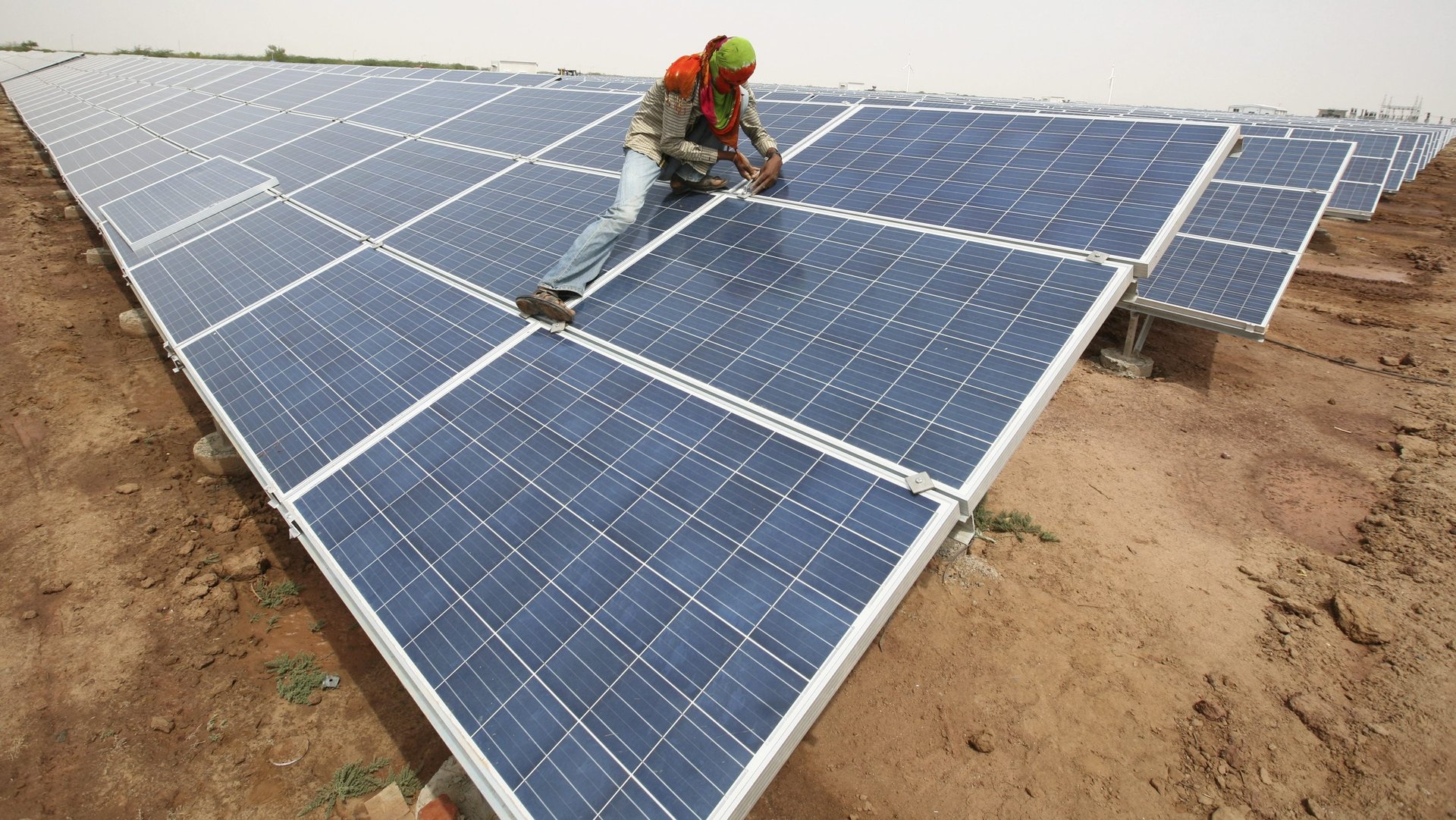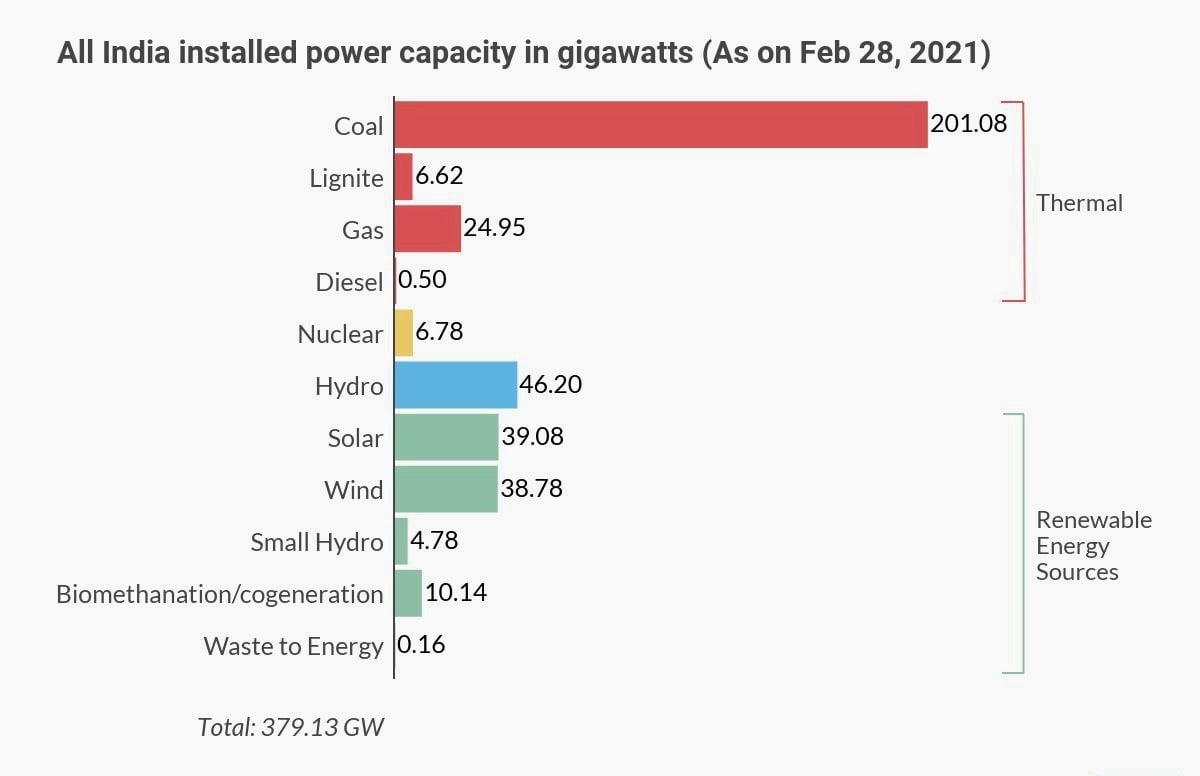India has big green energy dreams—but issues old and new persist
After Joe Biden took charge as the United States president, climate change is returning as a pillar of its collaboration with India. It emerged in the recently-held online meeting of the heads of states of the Quad countries—Australia, India, Japan and the US.


After Joe Biden took charge as the United States president, climate change is returning as a pillar of its collaboration with India. It emerged in the recently-held online meeting of the heads of states of the Quad countries—Australia, India, Japan and the US.
The joint statement issued by the leaders on March 12 says: “We will establish a climate working group to strengthen climate actions globally on mitigation, adaptation, resilience, technology, capacity-building, and climate finance. Our experts and senior officials will continue to meet regularly; our foreign ministers will converse often and meet at least once a year. At the leader level, we will hold an in-person summit by the end of 2021.”
It is significant that climate change emerged as a topic of discussion at the first important meeting (albeit online) between the US president and Indian prime minister. This is not the first time though that climate change was an ice breaker between the two heads of state.
Flashback to March 2000, the then US president Bill Clinton was visiting when the bilateral relations were just thawing after the economic sanctions imposed against India after the nuclear tests at Pokharan in May 1998. Even while the commentators predicted that Clinton would talk about defence and security, there were indications that the focus would be on green diplomacy.
This speculation turned out to be true and Clinton announced a package of green support while speaking in the foreground of the Taj Mahal. If Taj’s walls could get “marble cancer”, what impact would the pollution have on children, he wondered, while promising support for power sector reforms, clean and renewable energy, and energy efficiency. The green diplomacy continued when prime minister Atal Bihari Vajpayee visited the US later in 2000.
The contexts between 2000 and 2021 are slightly different though. According to data compiled from the Carbon Dioxide Information Analysis Center (CDIAC), India’s carbon dioxide emission in 2000 was 0.97 billion tonnes (BT), while that of the US was 6 BT. In 2019 (last compiled data), India’s emission had grown to 2.62 BT, while that of the US had reduced to 5.28 BT. In the case of per capita CO2 emissions in 2000 India’s value was 0.93 tonnes, while that of the US was 21.29 tonnes which in 2019 changed to 1.91 tonnes and 16.06 tonnes respectively.
In 2000, the US was among the countries that had binding emission reduction targets under the Climate Change Convention, while India did not have any. The Kyoto Protocol had made it possible for the two countries to cooperate under the Clean Development Mechanism, where the US could get carbon credit for its mitigation and adaptation work in India.
However, in 2021, India is as committed to emission reduction as the US is. The Paris Agreement of December 2015 bound every country to have emission reduction ambitions, even though they were self-mandated through the intended nationally determined contributions (INDCs). Thus, in the changed paradigm, where India has major energy transition ambitions, climate mitigation and adaptation interventions provide a good opportunity for diplomatic and business collaborations.
India’s energy transition
On Oct. 2, 2015, before the Conference of Parties (CoP) at Paris, India announced its intended nationally determined contributions for emission reduction. It committed to reducing the emissions intensity of its gross domestic product (GDP) by 33% to 35% by 2030 from the 2005 level. To strengthen the share of renewable energy in the country it decided to achieve about 40% cumulative electric power installed capacity from non-fossil fuel-based energy resources by 2030. To enhance carbon sequestration an additional carbon sink of 2.5 to 3 billion tonnes of CO2 equivalent will be created through additional forest and tree cover by 2030.
The commitment in the INDC is to achieve 175 gigawatts (GW) of energy capacity through renewable sources by 2022. Speaking at the Climate Action Summit organised by the United Nations General Secretary on Sept. 23, 2019, Prime Minister Narendra Modi pledged to go beyond the 175 GW committed for 2022 and later up to 450 GW.
Keeping up with its INDC commitment since the Paris Agreement, India has been steadily increasing the growth rate for renewable energy vis-à-vis conventional energy. While the growth percentage in 2015-16 for renewable and conventional was 6.47% and 5.64% respectively, in 2019-20 the relative growth percentage was 9.12% and 0.12%. The years 2016-17 and 2018-19 averaged an annual growth rate of around 24% for the renewable sector.
Currently, according to the Ministry of Power data, till the end of February 2021, India has a total installed capacity of 379.13 GW. Of this, thermal power capacity is 233.17 GW (61.5%), hydro is 46.20 GW (12.19%), nuclear is 6.78 GW (1.79%) and renewable energy is 92.97 GW (24.52%).

The expected outlook till 2040
According to the India Energy Outlook 2021, the pandemic has dampened India’s energy demand growth story. It was earlier estimated that the demand would go by 50% between 2019 and 2030. However, now it is more in the range of 35%. “An expanding economy, population, urbanisation and industrialisation mean that India sees the largest increase in energy demand of any country to 2040.”
Solar power, the report forecasts, will match coal’s share in the energy mix within the next two decades, which is a sharp growth trajectory. This would put greater emphasis on robust grids and other sources of flexibility, and India could become a global leader in battery storage. All this together will help the country exceed its INDC commitment of 40% share of electricity generation through non-fossil fuels. The report estimates a 60% share for renewable energy.
When a country of India’s size, with a population exceeding 1.3 billion, goes into an energy transition, it attracts global attention. “As the world seeks ways to accelerate the pace of transformation in the energy sector, India is in a unique position to pioneer a new model for low-carbon, inclusive growth,” states the India Energy Outlook 2021 report by the International Energy Agency. “India’s energy destiny will be forged by government policies,” the report emphasises.
Two steps forward, one step back?
It is in this realm of government policy the messages are mixed. While on the one hand, the national government is promoting renewable energy, on the other fossil fuels are also getting increased policy support. As part of the package to help the country recover from the Covid-19 lockdown-induced economic crisis, measures were launched to privatise and permit commercial mining of coal.
The government also announced structural changes in the mining sector to improve the ease of doing business and easing of the Environment Impact Assessment notification. There is a thrust to dig more for coal, with thermal power plants encouraged to use domestic coal. There are mining reforms, the introduction of a single-window clearance system and easing of public hearing for legacy mines. Overall the message seems to promote increased coal mining.
It is ironic that the government is pushing coal while the plant load factor (power generation with reference to the maximum power that can be generated) for thermal power plants has decreased from 77.5% in 2009-2010 to 55.99% in 2019-20. In the same period, the energy deficit—the difference between the country’s energy needs and the energy generation—decreased from 10.1% in 2009-10 to 0.5% in 2019-20. Thus, even while the thermal power plants have generated less in terms of their capacities in the past ten years, it has not added to the energy deficit, indicating that other energy sources have grown into the gap and even filled in new space.
Green will lose its shine if legacy and new issues are not taken care of
The classical understanding of energy transition is that when fossil-fuel-based energy generation gives way to renewable energy then it is a positive environmental transition. This is true only at the surface, because not only does the transition carry forward some of the legacy issues, but also introduces new ones. Thus, India stands at the threshold of transition on a global scale and the opportunity and challenge are to make the process environmentally and socially just.
As the projection is for solar photovoltaic taking over from thermal power in the coming decades, land conflicts will continue unless care is not taken. According to an early (2007) Central Electricity Authority calculation, a 1,000 megawatt (MW) thermal power plant using indigenous coal will require 574 hectares (1,420 acres). It is significantly lesser if the power plant uses imported coal and is based near the coast.
In comparison, according to an estimate by the Central Electricity Regulatory Commission, every megawatt (MW) of solar photovoltaic requires 2.5 hectares of land. For wind energy and biomass, the packing density is less, thereby the land requirement is greater than that for solar. A recent study published in Scientific Reports from the Nature Group estimates that in a scenario where if by the year 2050 of India’s total energy production 54 percent is from solar then it would require 0.7 percent to 0.9 percent of the total land area.
India’s energy transition will have greater pressure on land than the thermal energy that it will replace. This could mean greater conversion from agricultural lands, biodiversity-rich lands or lands earmarked for other development activities. It could also mean greater land conflicts.
Fixing solar panels on rooftops can reduce land requirement, but decentralised collection and distribution of energy could have greater management complications. Moreover, it is only the utility-scale aggregation of solar power generation that can help in the large scale transition that India needs.
A more recent offshoot is the idea of anchoring solar photovoltaic panels on water bodies. These in turn can lead to environmental concerns.
There is also the possibility of renewable energy projects covering deeper underlying environmental issues. For instance, the international airport at Kochi in Kerala is presented as an institution totally powered by solar energy. Even though it is a commendable achievement, the airport flooded during the rains in 2018 and 2019, and all relief and rescue activities had to be carried out from the smaller naval airport. The airport has been sited on reclaimed paddy fields, at a point where the Periyar river takes a turn, making it flood-prone and thereby a non-climate resilient structure.
Another such challenge that awaits India, focusing on the large-scale adoption of electric vehicles, is ensuring a clean supply chain of batteries.
An opportunity for growth with sustainability and equity
Considering that India’s energy growth story is still a work in progress, the transition to renewable power can hold the greenhouse gas emissions curve from growing sharply. A reduction in emissions could mean a lesser increase in average temperatures across the subcontinent, lesser changes in agricultural productivity, and fewer and less intense extreme weather events.
These are certainly impacts to aim for. But the means of the transition process are as important as the end, and therein lies the opportunity and the challenge. If the energy transition targets are reached out for without considering the adverse environmental and social impacts, then the green may not be what the country aspires for. The challenge is to get the process right. This is the opportunity for India’s growth with sustainability and equity in the coming decades.
This post first appeared on Mongabay. We welcome your comments at [email protected].